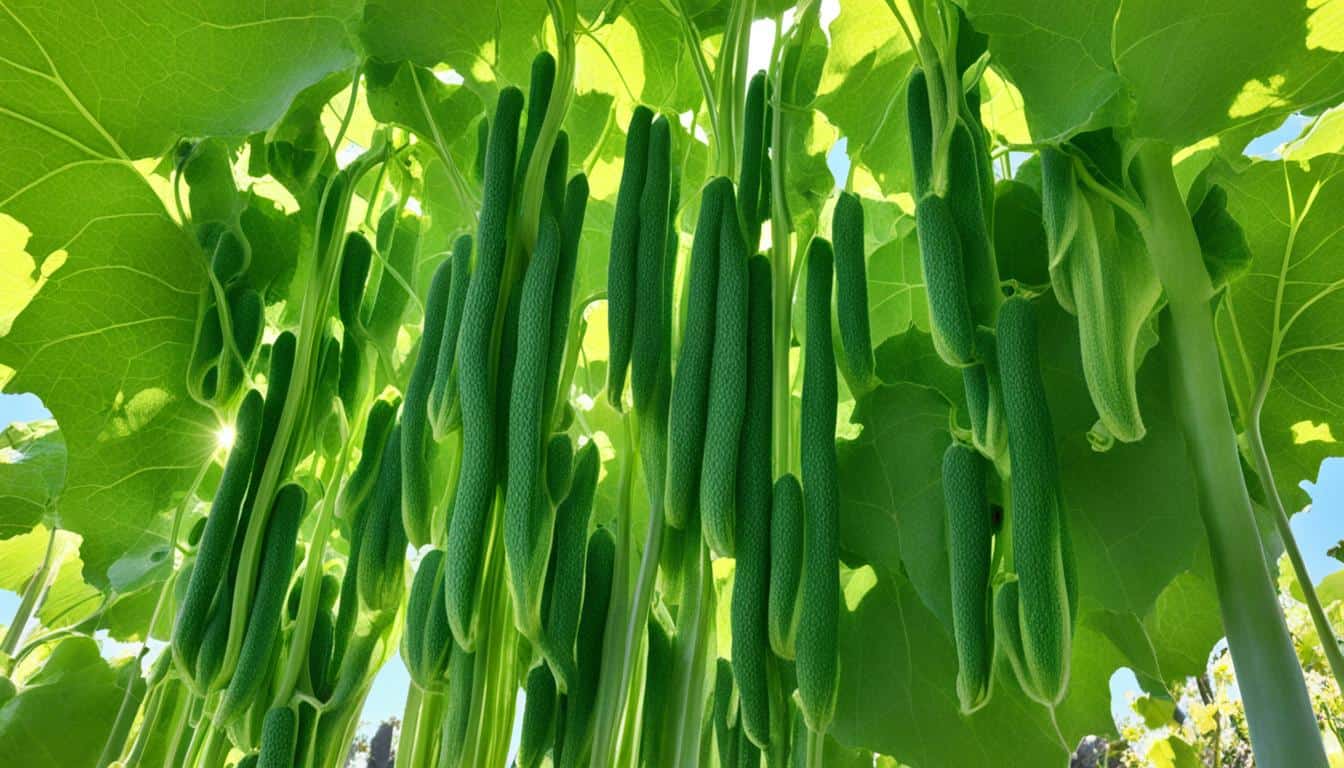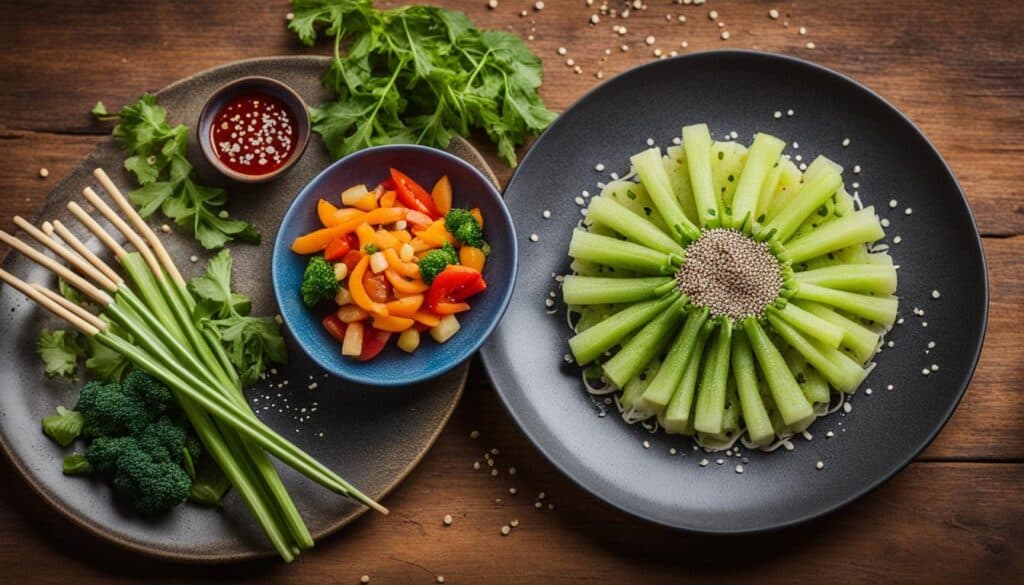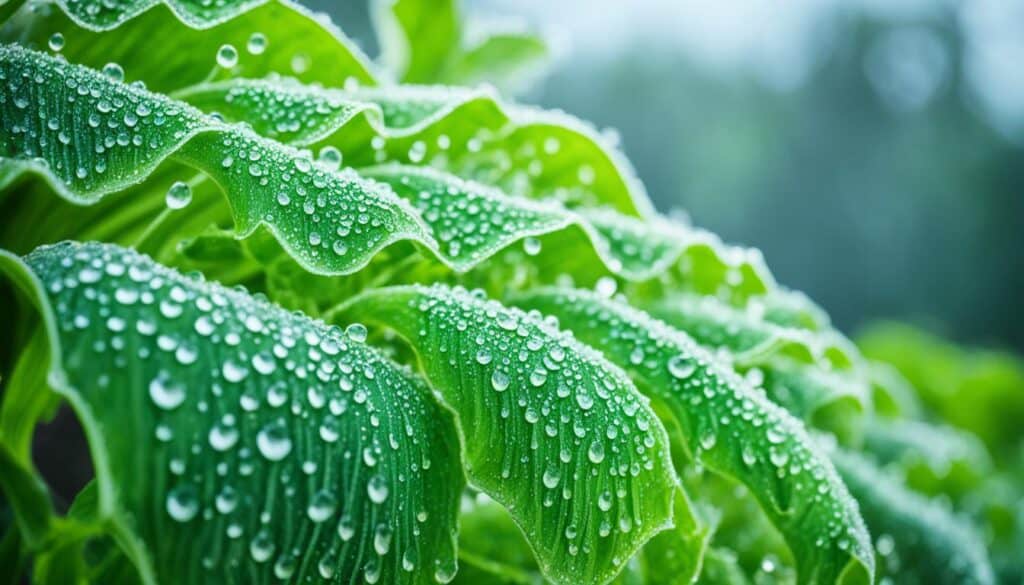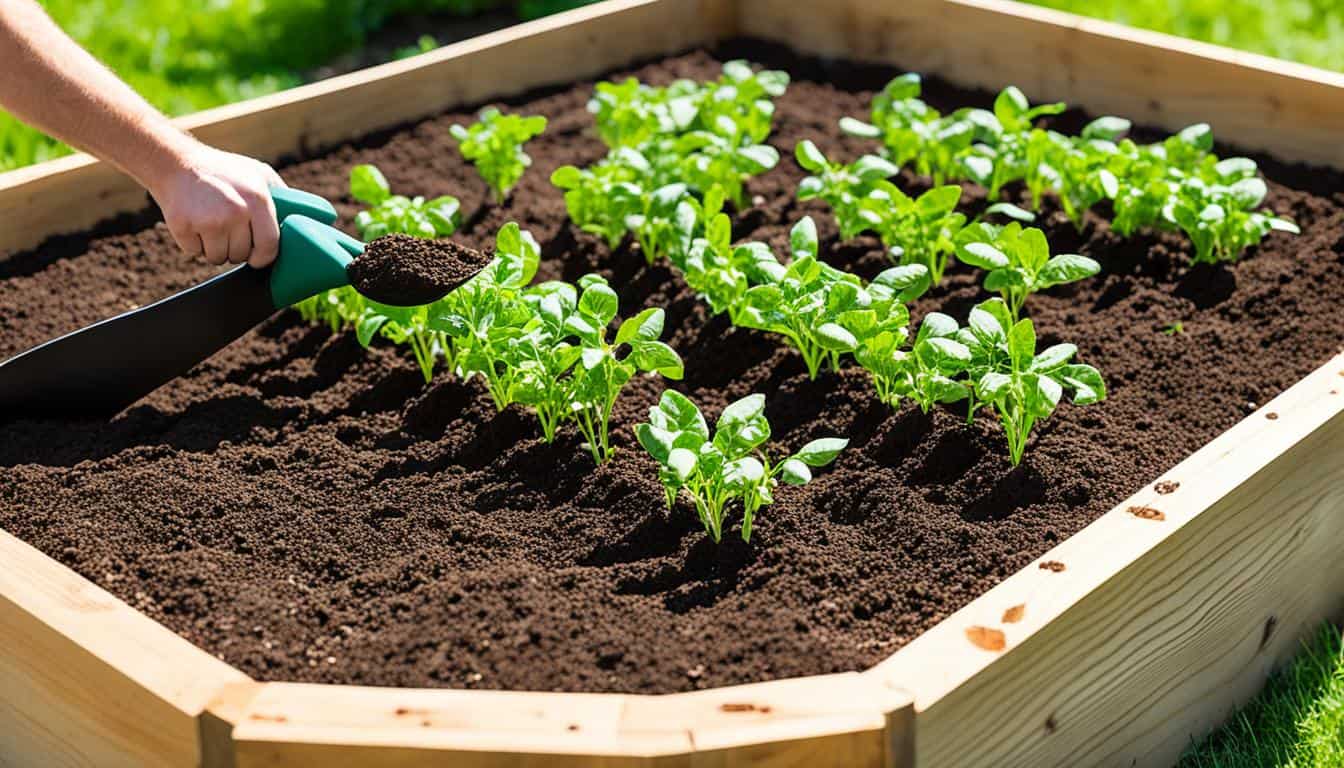Did you know that luffa acutangula, also known as sponge gourd, angled luffa, or ridged gourd, is a powerhouse of nutrients? This unassuming plant is packed with vitamins A, C, and K, as well as minerals like iron, potassium, and calcium. Not only that, but it’s also rich in dietary fiber and water content. In this article, I will delve into the benefits of luffa, how to grow and care for it, and even share some delicious recipes.
Key Takeaways
- Luffa acutangula, or sponge gourd, is a nutrient-rich plant with vitamins and minerals.
- Growing luffa in your garden can provide you with a fresh supply of this versatile ingredient.
- Luffa has a wide range of uses, from culinary dishes to skincare and crafting.
- Adding luffa to your diet can support digestion, heart health, and immune function.
- Stay tuned to learn how to incorporate luffa into your life and reap its benefits!
The Nutrient-Rich Ridge Gourd
When it comes to health benefits, ridge gourd, also known as luffa acutangula, is a powerhouse. Not only is it delicious, but it also offers a wide range of advantages for your well-being.
First and foremost, ridge gourd is a low-calorie vegetable, which makes it an excellent addition to weight management and calorie-conscious diets. You can enjoy its delicious taste without worrying about exceeding your calorie limit.
But that’s not all! Ridge gourd is also a great source of dietary fiber. By including it in your diet, you can support digestive health and prevent constipation. The fiber content helps regulate bowel movements and keeps your system running smoothly.
The high water content in ridge gourd provides hydration and maintains fluid balance in the body. Staying hydrated is essential for overall health, and ridge gourd can contribute to meeting your hydration needs.
Furthermore, ridge gourd contains potassium, a mineral that plays a vital role in regulating blood pressure and maintaining heart health. Consuming ridge gourd regularly can help support a healthy cardiovascular system.
The fiber in ridge gourd not only aids in digestion but also helps stabilize blood sugar levels. This is particularly beneficial for individuals with diabetes or those looking to manage their blood sugar levels effectively.
Ridge gourd is a natural source of vitamins A and K, which are essential for various bodily functions. Vitamin A supports vision health and promotes healthy skin, while vitamin K plays a crucial role in blood clotting and bone health.
Moreover, ridge gourd exhibits anti-inflammatory properties, which can help reduce inflammation in the body and alleviate symptoms associated with conditions like arthritis.
So, to summarize, the benefits of ridge gourd (luffa acutangula) include:
- Low calorie content
- Dietary fiber for digestive health
- High water content for hydration
- Potassium for regulating blood pressure
- Stabilizing blood sugar levels
- Promoting a healthy immune system
- Supporting healthy skin and vision
- Contributing to strong bones
- Anti-inflammatory properties
With these incredible benefits, ridge gourd is definitely a vegetable that deserves a place in your diet.
| Nutrition Facts | Amount per 100g |
|---|---|
| Calories | 20 |
| Carbohydrates | 4g |
| Fiber | 1.2g |
| Potassium | 170mg |
| Vitamin A | 45% of the DV |
| Vitamin K | 100% of the DV |
Cultivating Luffa in Your Garden
Growing luffa acutangula in your garden is a rewarding endeavor that can provide you with fresh and nutritious produce. With the right care and attention, you can enjoy a bountiful harvest of luffa fruits. Here are some essential tips for successfully growing luffa and maintaining its optimal health:
- Choose a warm and sunny location: Luffa acutangula thrives in full sunlight, so select a spot in your garden that receives at least 6 to 8 hours of direct sunlight each day.
- Ensure well-drained soil: Luffa plants prefer soil that drains well to avoid waterlogging. Amend heavy clay soils with organic matter such as compost or well-rotted manure to improve drainage.
- Planting in spring: Wait until the threat of frost has passed before planting luffa seeds in spring. Luffa plants are sensitive to cold temperatures and frost can damage or kill the young seedlings.
- Provide vertical support: Luffa plants are vigorous climbers and require support to grow vertically. Install trellises, fences, or other sturdy structures for the vines to climb upon.
- Water regularly: Keep the soil evenly moist throughout the growing season. Luffa plants require regular watering, especially during dry spells. Avoid overwatering, as excessive moisture can lead to root rot.
- Occasional fertilization: Apply a balanced organic fertilizer, such as compost or well-rotted manure, every 4 to 6 weeks to provide essential nutrients for healthy plant growth.
- Harvesting at the right time: Luffa fruits are best harvested when they are young and tender. Typically, this occurs around 60 to 90 days after planting. Harvesting the fruits early ensures a mild and flavorful taste.
By following these simple guidelines, you can cultivate thriving luffa plants in your garden and enjoy the satisfaction of growing your own organic luffa fruits.
Delicious Recipes with Luffa
When it comes to luffa, the possibilities in the kitchen are endless. This versatile ingredient can add a unique texture and flavor to a variety of dishes. Here are some delicious recipes to help you explore the culinary potential of luffa:
1. Stir-Fried Luffa with Garlic
This simple yet flavorful dish is a popular way to enjoy luffa. Sliced luffa is stir-fried with garlic, soy sauce, and a touch of sugar for a sweet and savory taste. Serve it as a side dish or over steamed rice for a satisfying meal.
2. Luffa Curry
Spice up your dinner with a luffa curry. This aromatic dish combines luffa with a blend of Indian spices, coconut milk, and tomatoes. The result is a creamy and rich curry that pairs perfectly with naan bread or rice.
3. Luffa Soup
Warm up with a comforting bowl of luffa soup. This recipe combines luffa with chicken or vegetable broth, onions, garlic, and your choice of herbs and spices. The result is a nourishing soup that is both flavorful and satisfying.
“Luffa is a versatile ingredient that adds a unique texture and flavor to dishes. From stir-fries to curries and soups, there are so many delicious recipes to explore.” – Me
Not only is luffa delicious, but it is also highly nutritious. It is packed with vitamins, minerals, and dietary fiber, making it a great addition to a healthy diet.
Now that you know how to make the most of luffa in the kitchen, it’s time to get cooking and discover the wonderful flavors this ingredient has to offer.
| Recipe | Description |
|---|---|
| Stir-Fried Luffa with Garlic | A simple and flavorful dish that combines luffa with garlic, soy sauce, and a touch of sugar. |
| Luffa Curry | A delicious Indian-inspired curry that combines luffa with a blend of spices, coconut milk, and tomatoes. |
| Luffa Soup | A comforting and nourishing soup that combines luffa with chicken or vegetable broth, onions, garlic, and herbs. |
Beyond Kitchen Recipes
Luffa acutangula, also known as sponge gourd or ridge gourd, offers a wide range of uses beyond just cooking. Its fibrous texture makes it an excellent natural sponge for bathing and cleaning. The mature luffa is known for its exfoliating properties, making it a popular choice for natural skincare products. Additionally, luffa can be utilized in various crafting projects, such as creating decorative items or even musical instruments. Its versatility makes it a valuable addition to any garden.
Uses of Luffa Acutangula:
- Bathing: The fibrous texture of mature luffa makes it perfect for scrubbing and exfoliating the skin, leaving it soft and smooth.
- Cleaning: Luffa can be used as a natural sponge for cleaning various surfaces, making it an eco-friendly alternative to synthetic cleaning products.
- Skincare: Due to its exfoliating properties, luffa is often incorporated into natural skincare products like scrubs, soaps, and facial cleansers.
- Crafting: The unique texture and shape of luffa make it perfect for crafting projects. It can be carved, painted, or woven into decorative items or even used to create unique musical instruments.
“Luffa acutangula is not only a culinary delight but also a versatile plant that offers a wide array of uses in everyday life. From enhancing your bathing experience to creating beautiful crafts, luffa can truly elevate your lifestyle.” – Jane Smith, Gardening Enthusiast
Stay tuned to discover even more about the potential and benefits of luffa acutangula in the next section of this article.
| Benefit | Usage |
|---|---|
| Exfoliation | Use as a natural sponge for gentle scrubbing and exfoliation. |
| Cleaning | Utilize as a sustainable and eco-friendly alternative for household cleaning needs. |
| Skincare | Incorporate into homemade skincare products like scrubs and soaps for glowing skin. |
| Crafting | Create unique decorative pieces or musical instruments with the fibrous texture of luffa. |
Exploring the Potential of Luffa Acutangula
Luffa acutangula, also known as sponge gourd, is a versatile plant that offers numerous benefits for both health and household use. This nutrient-packed fruit is not only low in calories but also supports various aspects of well-being, including digestion, heart health, and immune function.
One of the great things about luffa acutangula is that it can be grown in your very own garden. Whether you have a spacious backyard or a small balcony, cultivating luffa can be a rewarding experience. With the right care and attention, you’ll be able to enjoy the benefits of this unique plant right at home.
Not only is luffa acutangula a delight to grow, but it’s also incredibly versatile in the kitchen. From stir-fries to soups, luffa can elevate your recipes with its refreshing crunch and subtle flavor. Additionally, luffa can be pickled or fermented for a unique taste experience. Its versatility in the kitchen is truly remarkable.
But the potential of luffa acutangula doesn’t stop there. Beyond culinary uses, luffa can also be utilized in skincare and crafting. The fibrous texture of mature luffa makes it an excellent natural sponge for exfoliating and cleansing the skin. Furthermore, luffa can be transformed into decorative items or even used to create musical instruments. Its uses are only limited by your imagination.
With its numerous benefits and multiple uses, luffa acutangula has the potential to enhance your lifestyle in many ways. Whether you’re looking to improve your health, explore new recipes, or engage in creative projects, luffa acutangula is a fantastic addition to your life. So why not unlock the secrets of luffa acutangula and enjoy its benefits today?







Leave a Reply